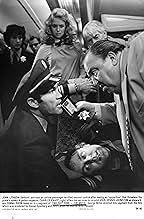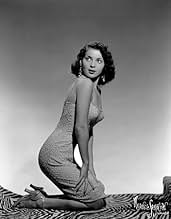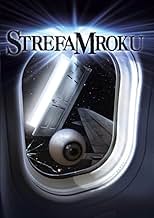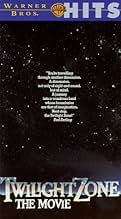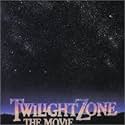Adicionar um enredo no seu idiomaFour horror and science fiction segments, directed by four famous directors, each of them being a new version of a classic story from Rod Serling's landmark television series.Four horror and science fiction segments, directed by four famous directors, each of them being a new version of a classic story from Rod Serling's landmark television series.Four horror and science fiction segments, directed by four famous directors, each of them being a new version of a classic story from Rod Serling's landmark television series.
- Prêmios
- 1 vitória e 8 indicações no total
Rainer Peets
- German Officer (segment "Time Out")
- (as Remus Peets)
William S. Taylor
- G.I. (segment "Time Out")
- (as William B. Taylor)
Avaliações em destaque
Feature film expansion of legendary TV series is uneven overall, but it does have its moments, and it does thankfully follow the rule of saving the best for last. Four prominent directors are brought together to create, in glorious colour, some classic episodes of the series, with an impressive roster of stars and character players. At least along the way it manages to create some enjoyable jolts. Burgess Meredith, star of 'Time Enough at Last', one of the best known and most beloved of all episodes, is the narrator for this trip into some bizarre places.
Unfortunately the movie will always have an enormous stigma attached to it due to the untimely and horrific death of actor Vic Morrow and two child extras during the shooting of Segment 1. That may very well leave a bad taste in the mouth of many people watching. It's up to the individual viewer as to how much this affects their enjoyment of the film.
The prologue and the first segment are actually originals written by director John Landis. Dan Aykroyd and Albert Brooks are fun as a passenger and driver who come up some with some amusing ways to entertain each other until Aykroyd decides it's time for Brooks to get a good scare. This gets us off to a good start because Landis does understand that with the TV show the payoff was a most important element.
Segment 1 sees Morrow playing an unrepentant bigot who gets a major dose of his own intolerance when he's mistaken for a Jew by Nazis, a black by KKK members, and a Vietnamese man by American troops in 'Nam. This is a very dark episode that doesn't end too satisfactorily, but Morrow is excellent, the look of Paris during WWII is nicely realized, the pacing is effective, and there's a great in joke referring back to Landis's "Animal House".
Segment 2, Steven Spielberg's remake of "Kick the Can", sees wonderfully genial Scatman Crothers injecting some magic into the lives of senior citizens in an old folks' home. Like Segment 1, it's unfortunately not subtle about its message, and is so syrupy sweet that it really doesn't fit in with the other segments here. The actors are very likable, fortunately; Crothers manages to make it worth sitting through.
Segment 3 tells the tale of "It's a Boy's Life", in which a creepy kid (Jeremy Licht) makes the acquaintance of travelling schoolteacher Kathleen Quinlan. This kid can bend reality to suit his whims, lives in a house with bizarre designs, likes his hamburgers with peanut butter topping, and lives for cartoons. And his "family" lives in mortal terror of him. The work of Joe Dante, this serves as a counterpoint to Spielberg's tale the way that it depicts childish fantasies run amok. Great cartoon style monster work by Rob Bottin helps in the enjoyment of this segment; this is where the film starts getting really good. Bill Mumy, the kid in the original episode, plays a diner patron.
Segment 4, directed by George Miller of the "Mad Max" series, is far and away the best, an over the top remake of "Nightmare at 20,000 Feet", in which terrified airplane passenger John Lithgow believes he sees a creature busy destroying the planes' engines as it flies through a storm. Lots of good atmosphere and intensity here, with a top notch unhinged performance by Lithgow and a great creature, designed by Craig Reardon & Michael McCracken and performed by actor Larry Cedar.
With a lot of familiar faces in the small roles (ex. Charles Hallahan, Doug McGrath, Bill Quinn, Selma Diamond, the almighty Dick Miller (once again playing 'Walter Paisley'), Kevin McCarthy, William Schallert, Cherie Currie, Nancy Cartwright, John Dennis Johnston, Eduard Franz, and Donna Dixon), and wonderful music by Jerry Goldsmith, this certainly remains an entertaining film to watch for its duration, if not a great one. Hopefully it will inspire people to check out the TV series and see why it's so admired.
Seven out of 10.
Unfortunately the movie will always have an enormous stigma attached to it due to the untimely and horrific death of actor Vic Morrow and two child extras during the shooting of Segment 1. That may very well leave a bad taste in the mouth of many people watching. It's up to the individual viewer as to how much this affects their enjoyment of the film.
The prologue and the first segment are actually originals written by director John Landis. Dan Aykroyd and Albert Brooks are fun as a passenger and driver who come up some with some amusing ways to entertain each other until Aykroyd decides it's time for Brooks to get a good scare. This gets us off to a good start because Landis does understand that with the TV show the payoff was a most important element.
Segment 1 sees Morrow playing an unrepentant bigot who gets a major dose of his own intolerance when he's mistaken for a Jew by Nazis, a black by KKK members, and a Vietnamese man by American troops in 'Nam. This is a very dark episode that doesn't end too satisfactorily, but Morrow is excellent, the look of Paris during WWII is nicely realized, the pacing is effective, and there's a great in joke referring back to Landis's "Animal House".
Segment 2, Steven Spielberg's remake of "Kick the Can", sees wonderfully genial Scatman Crothers injecting some magic into the lives of senior citizens in an old folks' home. Like Segment 1, it's unfortunately not subtle about its message, and is so syrupy sweet that it really doesn't fit in with the other segments here. The actors are very likable, fortunately; Crothers manages to make it worth sitting through.
Segment 3 tells the tale of "It's a Boy's Life", in which a creepy kid (Jeremy Licht) makes the acquaintance of travelling schoolteacher Kathleen Quinlan. This kid can bend reality to suit his whims, lives in a house with bizarre designs, likes his hamburgers with peanut butter topping, and lives for cartoons. And his "family" lives in mortal terror of him. The work of Joe Dante, this serves as a counterpoint to Spielberg's tale the way that it depicts childish fantasies run amok. Great cartoon style monster work by Rob Bottin helps in the enjoyment of this segment; this is where the film starts getting really good. Bill Mumy, the kid in the original episode, plays a diner patron.
Segment 4, directed by George Miller of the "Mad Max" series, is far and away the best, an over the top remake of "Nightmare at 20,000 Feet", in which terrified airplane passenger John Lithgow believes he sees a creature busy destroying the planes' engines as it flies through a storm. Lots of good atmosphere and intensity here, with a top notch unhinged performance by Lithgow and a great creature, designed by Craig Reardon & Michael McCracken and performed by actor Larry Cedar.
With a lot of familiar faces in the small roles (ex. Charles Hallahan, Doug McGrath, Bill Quinn, Selma Diamond, the almighty Dick Miller (once again playing 'Walter Paisley'), Kevin McCarthy, William Schallert, Cherie Currie, Nancy Cartwright, John Dennis Johnston, Eduard Franz, and Donna Dixon), and wonderful music by Jerry Goldsmith, this certainly remains an entertaining film to watch for its duration, if not a great one. Hopefully it will inspire people to check out the TV series and see why it's so admired.
Seven out of 10.
Prologue: a driver has a big surprise with his passenger (8)
Segment 1 ("Time Out"): a bigot man hates Jews, Black and Asian people. One day he will live in the World War II, hunted down by KKK and attacked in Vietnam War and feel the effects of his hatred. Good episode with a surprising conclusion (7).
Segment 2 ("Kick the Can"): In a nursing home, the elder inhabitants learn that their minds can keep them young. Reasonable episode only with a great homage to "The Twilight Zone" (Episode 3.21) "Kick the Can". (6).
Segment 3 ("It´s a Good Life"): a traveler hits a boy in a bicycle with her car and takes the boy home. Soon she learns that the powerful boy brought her home indeed. Good episode with a silly and disappointing conclusion (7).
Segment 4 ("Nightmare at 20,000 feet"): a writer is scary to fly and soon he sees a monstrous creature destroying the airplane engines during a stormy night. Certainly the best episode (8).
Divided in prologue and four segments, "Twilight Zone: The Movie" is a tragic and cult movie. Tragic since Vic Morrow, the unforgettable Sgt. Saunders of "Combat!" series, died in a weird accident when the helicopter crashed on him and two children while making a scene. Directed by four great directors - Joe Dante (segment "It's a Good Life"); John Landis (prologue/segment "Time Out"); George Miller (segment "Nightmare at 20,000 Feet"); and Steven Spielberg (segment "Kick the Can") - and with great names in the cast - Vic Morrow, Dan Aykroyd, Albert Brooks, Kathleen Quinlan, John Lithgow among many others, "Twilight Zone: The Movie" is highly recommended for fans of sci-fi and horror. My vote is seven.
Title (Brazil): "No Limite da Realidade" ("In the Limit of Reality")
Note: On 31 July 2023, I saw this film again.
Segment 2 ("Kick the Can"): In a nursing home, the elder inhabitants learn that their minds can keep them young. Reasonable episode only with a great homage to "The Twilight Zone" (Episode 3.21) "Kick the Can". (6).
Segment 3 ("It´s a Good Life"): a traveler hits a boy in a bicycle with her car and takes the boy home. Soon she learns that the powerful boy brought her home indeed. Good episode with a silly and disappointing conclusion (7).
Segment 4 ("Nightmare at 20,000 feet"): a writer is scary to fly and soon he sees a monstrous creature destroying the airplane engines during a stormy night. Certainly the best episode (8).
Divided in prologue and four segments, "Twilight Zone: The Movie" is a tragic and cult movie. Tragic since Vic Morrow, the unforgettable Sgt. Saunders of "Combat!" series, died in a weird accident when the helicopter crashed on him and two children while making a scene. Directed by four great directors - Joe Dante (segment "It's a Good Life"); John Landis (prologue/segment "Time Out"); George Miller (segment "Nightmare at 20,000 Feet"); and Steven Spielberg (segment "Kick the Can") - and with great names in the cast - Vic Morrow, Dan Aykroyd, Albert Brooks, Kathleen Quinlan, John Lithgow among many others, "Twilight Zone: The Movie" is highly recommended for fans of sci-fi and horror. My vote is seven.
Title (Brazil): "No Limite da Realidade" ("In the Limit of Reality")
Note: On 31 July 2023, I saw this film again.
Five episodes realized as tribute to Rod Serling's Twilight zone, made by four known directors . It's is divided into 4 parts , three of them real remakes from classic television series, though starts in a prologue stars Albert Brooks and Dan Aykroyd . The best directed by John Landis is the first, where a bigot (played by Vic Morrow who died during filming by a helicopter crash accident) who becomes pursued of evil Nazis, Ku Klux Klan and American soldiers in Vietnam. The second segment directed by Steven Spielberg is a silly story about old people living in a retirement house who turn into little boys, thanks a strange visitor (Scatman Crothers). The third directed by Joe Dante concerns about a young woman (Kathleen Quinlan) encounters a kid with rare powers and some people (Kevin McCarthy, William Schallert,among them) closed at a strange house. And fourth episode titled 'Nightmare at 20.000 Feet' deals with a terrified passenger(John Lightow) who watch a creepy monster making rare issues on the wing of the plane.
The picture contains good special effects in traditional style without excessive computer generator as usual nowadays. The master Jerry Goldsmith composes a magic musical score particularly reflected on the second episode titled 'Kick the can' . Colorful and imaginative cinematography especially in the third segment titled 'It's a good life'. Rating : Acceptable and passable, the picture will appeal to fantastic genre buffs.
The classic long-running television series is formed by 156 episodes and its narrator , of course, Rod Serling. Later on, in 2002 are realized 44 new episodes with Forest Whitaker as host.
The picture contains good special effects in traditional style without excessive computer generator as usual nowadays. The master Jerry Goldsmith composes a magic musical score particularly reflected on the second episode titled 'Kick the can' . Colorful and imaginative cinematography especially in the third segment titled 'It's a good life'. Rating : Acceptable and passable, the picture will appeal to fantastic genre buffs.
The classic long-running television series is formed by 156 episodes and its narrator , of course, Rod Serling. Later on, in 2002 are realized 44 new episodes with Forest Whitaker as host.
It is very hard to think of another film anywhere that had such a great potential as TWILIGHT ZONE: THE MOVIE had, only to have a senseless and totally preventable tragedy--the deaths of actor Vic Morrow and two illegally hired Asian child actors--mar the impact. Aside from that, and some heavy-handed moralizing that even the original show's creator Rod Serling would have had problems with, this is a fairly good tribute to what was perhaps the best TV series in history.
The prologue (with Dan Aykroyd and Albert Brooks) and Segment 1 are both originals, written and directed by John Landis. The segment deals with a very embittered white man (Morrow) who, after being dealt the denial of a promotion at work in favor of a Jew, unleashes his bigotry at a bar. But when he steps outside, he soon gets a dose of his own bitter medicine: persecution by the Nazis in Vichy France circa 1943; stalked by the KKK in Alabama in 1956; attacked by US soldiers in Vietnam circa 1969. Landis' penchant for hamfisted dialogue and erratic direction dilute what could have been an effective piece; and the tragedy that occurred on his watch taints not only this segment but much of the rest of the movie.
Segment 2, a remake of the 1961 episode "Kick The Can", directed by Steven Spielberg, stars Scatman Crothers as an elderly magician who brings a sense of youth to the residents of a senior citizens home, though over the objections of a veritable old fuddy-duddy (Bill Quinn). Spielberg has often been attacked, mostly unnecessarily, for his tendency toward sloppy sentimentality, but here a lot of the attacks may be justified, despite the best of intentions. He is still my favorite director, but this is one of his weakest.
Segment 3 remakes "It's A Good Life." Under the inventive hands of director Joe Dante (THE HOWLING), this film stars Jeremy Licht as a boy with the power to enslave and terrorize his family when he comes to feel that they hate him. Kathleen Quinlan stars as the teacher who unintentionally gets caught up in the melee, only to wind up volunteering to teach Licht how to better use his powers before they become too big for him to control (a la CARRIE). Dante's use of inventive special effects (courtesy of Rob Bottin) and black comedy enliven this segment, despite some weird overacting from the rest of the segment's cast (including William Schallert and Kevin McCarthy).
Segment 4 is a reworking of the famous episode "Nightmare At 20,000 Feet." With George Miller (MAD MAX) at the director's helm, the segment stars John Lithgow as an incredibly anxious passenger with a morbid fear of flight who constantly sees a monstrous gremlin tearing apart at the wings of his plane during a severe storm. His anxiety explodes into terror and madness, and the other passengers think he is certifiable. But when the plane lands, and the damage is inspected...
The final score on this is that Landis and Spielberg, who also produced, come up with the weaker segments, and Dante and, especially, Miller come up with the best ones. Miller's segment is a truly kinetic piece of suspense and terror, though I did find the little girl (Christina Nigra) an extremely obnoxious and unnecessary presence. Lithgow, who takes over for William Shatner (who had the role in the TV episode), gives a bravura performance, arguably paving the way for his role in "2010" as an astronaut deftly afraid of heights.
Jerry Goldsmith's usual efficient score and some good special effects work help to make TWILIGHT ZONE: THE MOVIE not only an above-average tribute to a great TV show, but also a good anthology film that combines fantasy, suspense, and mystery. It is a shame that the film is tainted by a pointless tragedy. But if one can ignore that, there are rewards to be had by seeing this.
The prologue (with Dan Aykroyd and Albert Brooks) and Segment 1 are both originals, written and directed by John Landis. The segment deals with a very embittered white man (Morrow) who, after being dealt the denial of a promotion at work in favor of a Jew, unleashes his bigotry at a bar. But when he steps outside, he soon gets a dose of his own bitter medicine: persecution by the Nazis in Vichy France circa 1943; stalked by the KKK in Alabama in 1956; attacked by US soldiers in Vietnam circa 1969. Landis' penchant for hamfisted dialogue and erratic direction dilute what could have been an effective piece; and the tragedy that occurred on his watch taints not only this segment but much of the rest of the movie.
Segment 2, a remake of the 1961 episode "Kick The Can", directed by Steven Spielberg, stars Scatman Crothers as an elderly magician who brings a sense of youth to the residents of a senior citizens home, though over the objections of a veritable old fuddy-duddy (Bill Quinn). Spielberg has often been attacked, mostly unnecessarily, for his tendency toward sloppy sentimentality, but here a lot of the attacks may be justified, despite the best of intentions. He is still my favorite director, but this is one of his weakest.
Segment 3 remakes "It's A Good Life." Under the inventive hands of director Joe Dante (THE HOWLING), this film stars Jeremy Licht as a boy with the power to enslave and terrorize his family when he comes to feel that they hate him. Kathleen Quinlan stars as the teacher who unintentionally gets caught up in the melee, only to wind up volunteering to teach Licht how to better use his powers before they become too big for him to control (a la CARRIE). Dante's use of inventive special effects (courtesy of Rob Bottin) and black comedy enliven this segment, despite some weird overacting from the rest of the segment's cast (including William Schallert and Kevin McCarthy).
Segment 4 is a reworking of the famous episode "Nightmare At 20,000 Feet." With George Miller (MAD MAX) at the director's helm, the segment stars John Lithgow as an incredibly anxious passenger with a morbid fear of flight who constantly sees a monstrous gremlin tearing apart at the wings of his plane during a severe storm. His anxiety explodes into terror and madness, and the other passengers think he is certifiable. But when the plane lands, and the damage is inspected...
The final score on this is that Landis and Spielberg, who also produced, come up with the weaker segments, and Dante and, especially, Miller come up with the best ones. Miller's segment is a truly kinetic piece of suspense and terror, though I did find the little girl (Christina Nigra) an extremely obnoxious and unnecessary presence. Lithgow, who takes over for William Shatner (who had the role in the TV episode), gives a bravura performance, arguably paving the way for his role in "2010" as an astronaut deftly afraid of heights.
Jerry Goldsmith's usual efficient score and some good special effects work help to make TWILIGHT ZONE: THE MOVIE not only an above-average tribute to a great TV show, but also a good anthology film that combines fantasy, suspense, and mystery. It is a shame that the film is tainted by a pointless tragedy. But if one can ignore that, there are rewards to be had by seeing this.
I'm a huge fan of the series, and I remember being obsessed with TZ The Movie when it was released. I was 12, after all!!
Recently watched the film again for the first time in at least 15 years. I was blown away by the final segment, it's truly a classic which really scared the stuffing outta me. That evil little girl who takes Polaroids of everything freaked me out to no end. For me, it's the only segment in which the quality of the writing matches the direction and visuals from beginning to end.
I saw the original episode upon which Joe Dante's (3rd) segment is based when I was spending the night at my friend's house in 4th grade. It, too, really frightened me. I remember thinking to myself how hopeless the situation was-- if you even TRIED to not think bad thoughts about Anthony, you would end up thinking them, and he could still get you!! And didn't he "wish someone away to the cornfield"?? Man, that's some serious freakiness.
I thought the design of that segment in the movie was incredible, I'll never forget the mom holding the fishbowl, or the ferocious rabbit creature, or what happens to Ethel ("Run, Ethel....!") But the ending is truly atrocious and almost ruins what has come before.
What can I say about the other two segments? Better scripts were needed in order to make them work. And in the case of "Kick the Can", sticking more closely to the original episode would have given it more impact. (Not to mention firing Steven Spielberg.)And it's sad seeing Vic Morrow in his final role-- I'll always think of him as the sadistic coach in THE BAD NEWS BEARS, which is one of my all-time favorites.
All in all, a very uneven movie which improves steadily as it goes along. 6/10.
Recently watched the film again for the first time in at least 15 years. I was blown away by the final segment, it's truly a classic which really scared the stuffing outta me. That evil little girl who takes Polaroids of everything freaked me out to no end. For me, it's the only segment in which the quality of the writing matches the direction and visuals from beginning to end.
I saw the original episode upon which Joe Dante's (3rd) segment is based when I was spending the night at my friend's house in 4th grade. It, too, really frightened me. I remember thinking to myself how hopeless the situation was-- if you even TRIED to not think bad thoughts about Anthony, you would end up thinking them, and he could still get you!! And didn't he "wish someone away to the cornfield"?? Man, that's some serious freakiness.
I thought the design of that segment in the movie was incredible, I'll never forget the mom holding the fishbowl, or the ferocious rabbit creature, or what happens to Ethel ("Run, Ethel....!") But the ending is truly atrocious and almost ruins what has come before.
What can I say about the other two segments? Better scripts were needed in order to make them work. And in the case of "Kick the Can", sticking more closely to the original episode would have given it more impact. (Not to mention firing Steven Spielberg.)And it's sad seeing Vic Morrow in his final role-- I'll always think of him as the sadistic coach in THE BAD NEWS BEARS, which is one of my all-time favorites.
All in all, a very uneven movie which improves steadily as it goes along. 6/10.
Você sabia?
- CuriosidadesThe scene being shot at the time of Vic Morrow's fatal accident was added to the script late in the filming in an attempt to "soften" his bigoted character Bill Connor, and give him some redemption: while fleeing from an American helicopter attack on a deserted Vietnamese village, he sees two orphaned children. Bill decides to save them no matter what the cost, so he carries them under his arms and wades through the river to safety. He then finds himself back in Nazi-occupied France again, the two children having time-jumped with him. The two Nazi officers chasing Bill take the children away for execution, and take Bill to a train which ends the segment. Due to the helicopter accident that claimed the life of Morrow and child actors Renee Chen and My-ca Dinh Le, all scenes featuring the children were completely cut, and they do not appear in the film. Bill's original scripted ending was kept in, leaving Bill's character change largely unaddressed and his fate unknown.
- Erros de gravaçãoAn exterior shot of the airplane in Segment #4 shows the landing gear to be in the down position. The pilot later comments that the plane would be landing in twenty minutes, far too long for gear to be down prior to touchdown.
- Citações
Car Passenger: Hey... you wanna see something really scary?
- Versões alternativasCBS edited 8 minutes from this film for its 1986 network television premiere.
- Trilhas sonorasNights Are Forever
Performed by Jennifer Warnes
Music by Jerry Goldsmith
Lyrics by John Bettis
Produced by Bruce Botnick with James Newton Howard
[Segment #1: playing when William enters the bar]
Principais escolhas
Faça login para avaliar e ver a lista de recomendações personalizadas
Detalhes
- Data de lançamento
- País de origem
- Idiomas
- Também conhecido como
- Al filo de la realidad
- Locações de filme
- 15238 Victory Boulevard, Van Nuys, Los Angeles, Califórnia, EUA(bar in segment #1; exterior & interior)
- Empresas de produção
- Consulte mais créditos da empresa na IMDbPro
Bilheteria
- Orçamento
- US$ 10.000.000 (estimativa)
- Faturamento bruto nos EUA e Canadá
- US$ 29.450.919
- Fim de semana de estreia nos EUA e Canadá
- US$ 6.614.366
- 26 de jun. de 1983
- Faturamento bruto mundial
- US$ 29.450.919
- Tempo de duração1 hora 41 minutos
- Cor
- Mixagem de som
- Proporção
- 1.85 : 1
Contribua para esta página
Sugerir uma alteração ou adicionar conteúdo ausente

Principal brecha
What is the Brazilian Portuguese language plot outline for No Limite da Realidade (1983)?
Responda


